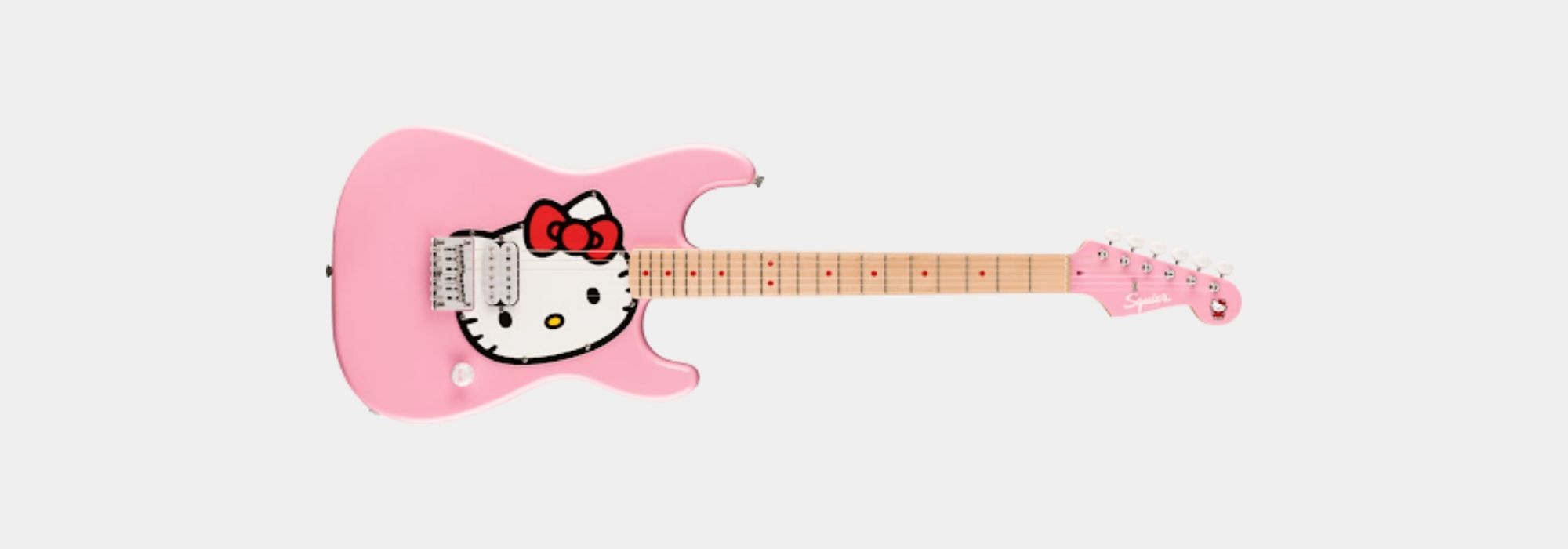Who would have guessed that one of the hottest guitars of the past few years would be pink, cartoon-branded, and adorned with Hello Kitty’s iconic face? The Reverb Price Index shows the Squier Hello Kitty Stratocaster has shot up in value. Stats show prices rising over 175% since 2019, even after dropping 27% in the last year.
Prices tripled at the height of its frenzy, fueled by viral videos from YouTuber The Dooo and a wave of nostalgic novelty. Fender then jumped in with a limited 50th anniversary reissue in November 2024. Originally sold at $499 and sold out, mint “purrfect” condition models now fetch as high as $1,200 on the resale market.
Musical instruments are one of the most overlooked, yet most profitable, categories to resell. Walk into any thrift store or donation warehouse and you’ll spot them. A beat-up guitar or a tarnished trumpet may not be trending, but hidden value can still be there.
Keeping up with viral trends isn’t the key to winning in this category. The resale of musical instruments is about spotting quality and craftsmanship.
That’s where Upright Labs’ latest Master Class, “Gigs to Gains: Maximize Profits with Musical Instruments,” comes in. We guide your team through simple steps to see the true value in instruments.
Get access to the full Master Class and download the presentation slides for a detailed walkthrough of instrument types and the key features to look for.
Who are your customers?
Knowing your target buyer helps shape your listing language, photo quality, and pricing strategy.
- Collectors look for rare or vintage pieces. They care most about originality and condition, and they’ll pay extra for it.
- Musicians want gear they can trust. Fixes and upgrades matter if they boost performance.
- Beginners and hobbyists look for budget-friendly instruments, often shopping local or online.
- Resellers hunt for bargains to flip. They buy big and don’t fuss over appearance.
Assessing Value
Key Evaluation Steps
When evaluating musical instruments for resale, there are four universal aspects to focus on. Each provides quick but reliable clues about whether a piece is high-quality, authentic, and worth listing.
1. Build & Materials
You can spot quality instruments by their build. A solid wood guitar or a heavy brass horn shows real craftsmanship. Metal knobs, jacks, and pedals beat cheap plastic. Ask: Is the wood grain real or laminate? Are the parts sturdy metal or flimsy plastic?
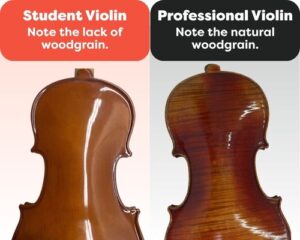
2. Fit & Finish
A closer look at the detailing will tell you even more. Clean seams, smooth fret edges, engraved or stamped logos, and durable finishes all point to higher value. Inlays and bindings made from real wood are another good sign, while rough edges, peeling finishes, or cheap sticker logos are red flags.
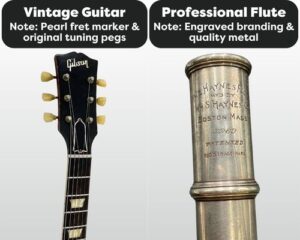
3. Wear & Damage
All used instruments show wear, but not all wear matters. Small scratches or tarnish can add charm. Big issues like cracks, warping, or bad wiring slash value. Watch for loose parts or water damage, which can make an item parts-only.
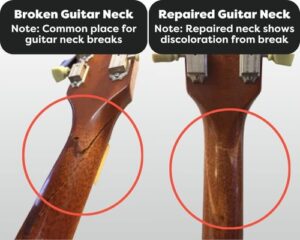
4. High-Demand Brands
Brand reputation shapes resale value. Well-known makers bring higher prices thanks to quality and loyal fans. Even worn pieces from top brands can sell strong.
Gibson is a prime example. The brand has a long history of exceptional craftsmanship and reliability, and its reputation carries over to resale. Gibson ranked #1 in average price per item in Q3, reaching $684.83.
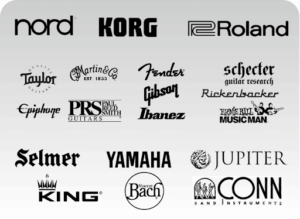
Signs of Counterfeits
Watch for red flags like bad logos, wrong serial numbers, cheap parts, or mismatched finishes. These are all signs the gear may be fake. Here’s a helpful video on spotting counterfeit guitars: Company Grip Guitar – Fake or Real? How to Spot a Counterfeit Gibson Guitar
Tools & Research
Evaluating instruments must go beyond the eye test. The right tools can help confirm authenticity, trace history, and establish fair resale value.
Google Lens for Visual ID
For older or heavily used gear, serial numbers may be illegible or absent. In these cases, using photo ID tools like Google Lens can help narrow down the model and year.
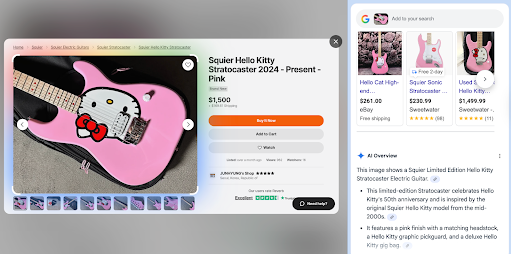
Resale Marketplaces & Price Guides
Sites like Reverb feature a “Price Guide” that aggregates real-world sale prices by brand and model. eBay’s “Sold Listings” filter is another practical way to benchmark value.
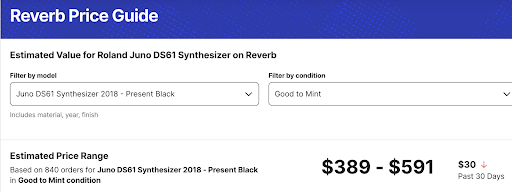
Reference Guides & Databases
Start with brand websites and trusted serial number databases. Many makers like Fender, Music Man, and Conn-Selmer publish searchable tools to confirm year and model. Aggregators like Music Trader are also helpful when you need to cross-check multiple brands.
Run a quick search for “[brand] serial number database.” Most reputable companies maintain their own records. For example:
- Fender: Serial Number Lookup
- Music Man: Database Tool
- Conn-Selmer: Serial Number List
These tools make up your authenticity toolkit, helping you confirm each item is real and priced right.
Grading Scale
A clear grading scale is key for secondhand instruments. It standardizes conditions and sets buyer expectations. Instruments are typically classified into five levels:
- Mint: like new, unplayed, with all original packaging
- Excellent: minimal wear, fully functional, with all original parts
- Very Good: moderate wear, minor cosmetic flaws, possibly with tasteful upgrades
- Fair: heavy wear, non-original parts, or repairs needed, but still playable
- Poor: significant damage or structural issues, often for parts or repair only
Condition can also be relative to the instrument’s age.
“A 70-year-old mandolin can’t be held to the same standard as one that was made this year. It’s important to keep in mind that it’s all relative, and if you’re in between two conditions, we recommend using the lower one to be safe.” Reverb – Gear Condition Guide
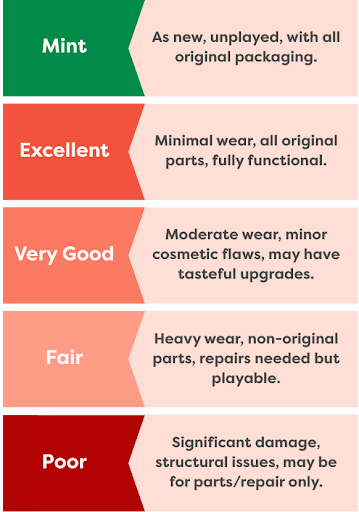
Vintage Versus Relic Guitars
Vintage guitars are usually 20+ years old and valued for their history, originality, and craftsmanship. Light wear, like finish checks or tarnish, can add charm, but collectors pay most for original parts, matching serials, and unmodified pieces.
Relic guitars are newer instruments intentionally aged to look worn. Brands like Fender’s Custom Shop create these to capture a vintage vibe without the high cost or fragility. Relics can resell well, especially from respected makers, but they rarely reach the prices of true vintage models.
Vintage gear draws collectors, while relics attract players who want style and playability. Accurate descriptions in listings are key to getting top value.
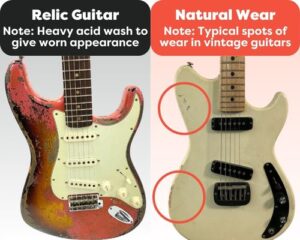
Listing Details for Musical Instruments
A strong listing can make the difference between a quick sale and a piece sitting unsold for months. When creating your listing, always include:
- Clear title: Use common search terms (e.g., “1994 Gibson Les Paul Standard Cherry Sunburst” rather than just “Gibson guitar”).
- Specifications: Manufacturer, model, year, wood type, pickups, hardware, and included accessories.
- Condition details: Be honest. Note cosmetic wear, missing parts, or repairs (e.g., “finish checking on body, replacement bridge installed”).
- Serial numbers and logos: Write them in the listing and provide photos for buyer verification.
- SEO keywords: Include brand, model, year, and finish so your listing appears in more searches.
Targeted description: Write with your buyer in mind. Collectors care about originality, musicians value playability, and beginners want affordability.
Photos Sell Instruments
Your team can’t know everything about reselling instruments, but your buyers often do. Musicians and collectors know what they want, so lean on their expertise by showing the instrument clearly in photos.
Shoot in natural light, from multiple angles, including these below:

- Full front & full back
- Close-ups of headstocks, tuners, knobs, etc.
- Include logos, models, and serial numbers
- Document all flaws
Transparency and a well-crafted listing builds buyer trust and maximizes resale value.
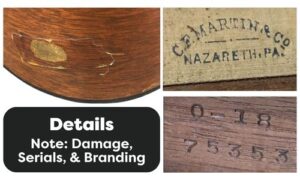
From Gigs to Gains: Make Every Instrument Count
The Hello Kitty Strat may grab headlines, but the real value lies in overlooked instruments on thrift shelves and donation racks. Sustainable growth comes from process, not hype. Musical instruments offer steady resale value, and now your team knows how to evaluate and present them effectively.

Connect with our team to learn how to maximize your results in the musical instruments category.


